The AMD Ryzen Threadripper 1950X and 1920X Review: CPUs on Steroids
by Ian Cutress on August 10, 2017 9:00 AM ESTCPU Rendering Tests
Rendering tests are a long-time favorite of reviewers and benchmarkers, as the code used by rendering packages is usually highly optimized to squeeze every little bit of performance out. Sometimes rendering programs end up being heavily memory dependent as well - when you have that many threads flying about with a ton of data, having low latency memory can be key to everything. Here we take a few of the usual rendering packages under Windows 10, as well as a few new interesting benchmarks.
All of our benchmark results can also be found in our benchmark engine, Bench.
Corona 1.3: link
Corona is a standalone package designed to assist software like 3ds Max and Maya with photorealism via ray tracing. It's simple - shoot rays, get pixels. OK, it's more complicated than that, but the benchmark renders a fixed scene six times and offers results in terms of time and rays per second. The official benchmark tables list user submitted results in terms of time, however I feel rays per second is a better metric (in general, scores where higher is better seem to be easier to explain anyway). Corona likes to pile on the threads, so the results end up being very staggered based on thread count.
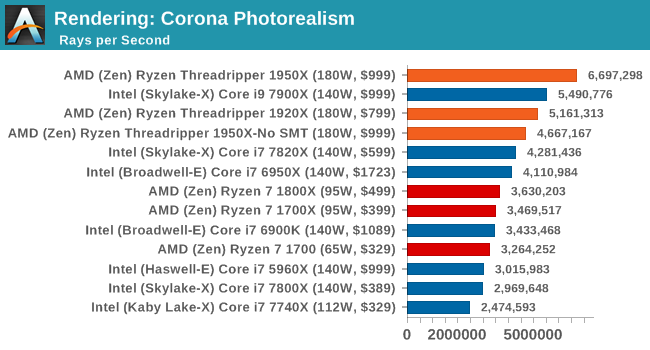
Corona loves threads.
Blender 2.78: link
For a render that has been around for what seems like ages, Blender is still a highly popular tool. We managed to wrap up a standard workload into the February 5 nightly build of Blender and measure the time it takes to render the first frame of the scene. Being one of the bigger open source tools out there, it means both AMD and Intel work actively to help improve the codebase, for better or for worse on their own/each other's microarchitecture.
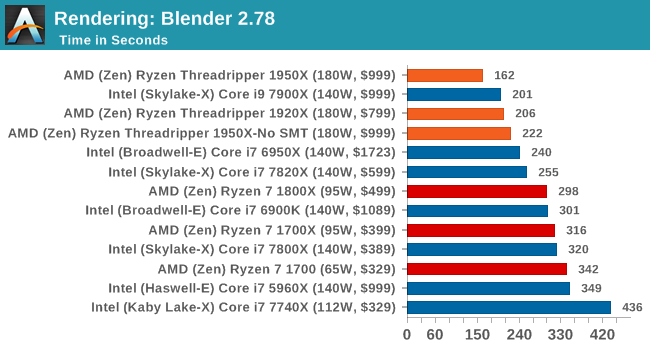
Blender loves threads and memory bandwidth.
LuxMark v3.1: Link
As a synthetic, LuxMark might come across as somewhat arbitrary as a renderer, given that it's mainly used to test GPUs, but it does offer both an OpenCL and a standard C++ mode. In this instance, aside from seeing the comparison in each coding mode for cores and IPC, we also get to see the difference in performance moving from a C++ based code-stack to an OpenCL one with a CPU as the main host.
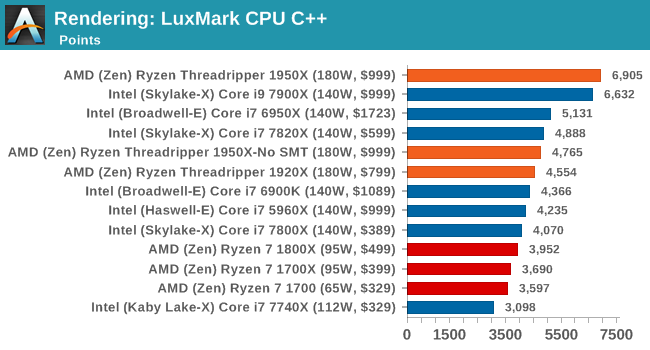
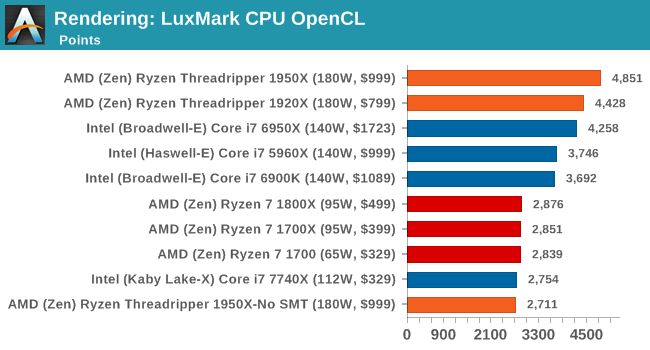
Like Blender, LuxMark is all about the thread count. Ray tracing is very nearly a textbook case for easy multi-threaded scaling. Though it's interesting just how close the 10-core Core i9-7900X gets in the CPU (C++) test despite a significant core count disadvantage, likely due to a combination of higher IPC and clockspeeds.
POV-Ray 3.7.1b4: link
Another regular benchmark in most suites, POV-Ray is another ray-tracer but has been around for many years. It just so happens that during the run up to AMD's Ryzen launch, the code base started to get active again with developers making changes to the code and pushing out updates. Our version and benchmarking started just before that was happening, but given time we will see where the POV-Ray code ends up and adjust in due course.
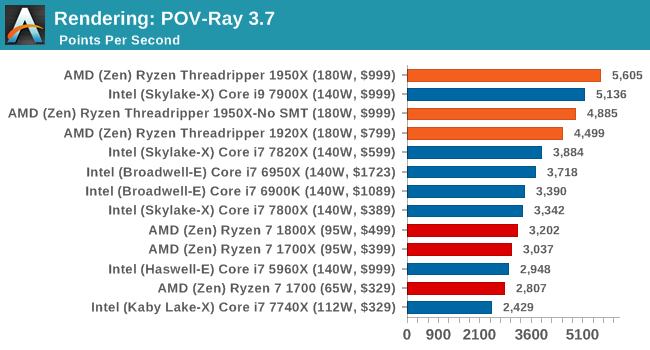
Similar to LuxMark, POV-Ray also wins on account of threads.
Cinebench R15: link
The latest version of CineBench has also become one of those 'used everywhere' benchmarks, particularly as an indicator of single thread performance. High IPC and high frequency gives performance in ST, whereas having good scaling and many cores is where the MT test wins out.
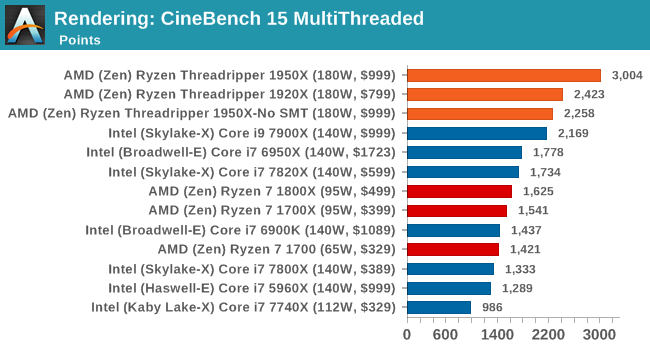
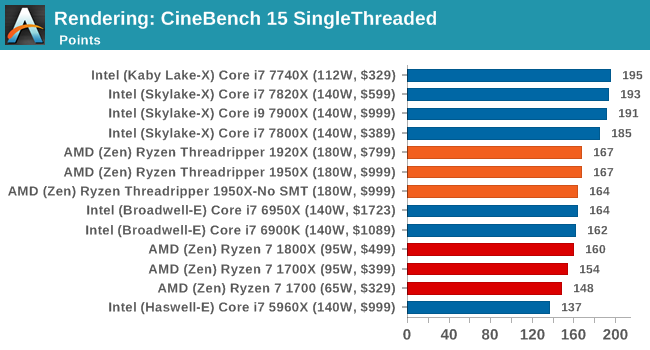
Intel recently announced that its new 18-core chip scores 3200 on Cinebench R15. That would be an extra 6.7% performance over the Threadripper 1950X for 2x the cost.










347 Comments
View All Comments
Notmyusualid - Sunday, August 13, 2017 - link
@ AlexeyNope - it means comparisons are easier than ever. If that means anything to you.
Alexey291 - Monday, August 14, 2017 - link
Why yes, I can compare some results of performance in software which is so outdated that it's half a dozen major versions behind...So as I was saying. Useless information.
Lolimaster - Friday, August 11, 2017 - link
You can add 2 results, one for comparison purposes and one with always the newest version available.Alexey291 - Saturday, August 12, 2017 - link
Would involve work as opposed to just running a macro once in a whileTypo - Thursday, August 10, 2017 - link
I wonder if the TR 1900x will get its own mode? Something like game mode but still retains smt?Yojimbo - Thursday, August 10, 2017 - link
It would be cool if you tested time between turns for a few late-game Civilization VI saves.Ian Cutress - Thursday, August 10, 2017 - link
When the developers of Civ finally listen to me and add in a command line for the AI benchmark, I can script it into my setup. They keep ignoring me. They have a command line for the regular benchmark, but because the AI benchmark was added post release no-one thought to add a command line for it (or publish what the command line flags are). There is an -aibenchmark flag in the disassembled code, but it doesn't do anything, which makes me think that it is disabled for release builds.rtho782 - Thursday, August 10, 2017 - link
http://www.anandtech.com/show/11685 <--- this link to the motherboard roundup just takes you to the homepage.Ian Cutress - Thursday, August 10, 2017 - link
It's still a WIP, needs expanding and editing. Will be doing that over the weekend :)Arbie - Thursday, August 10, 2017 - link
FYI, this sentence needs some repair work:"Though it's interesting just how cost the 10-thread Core i9-7900X gets here"